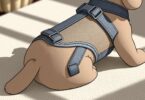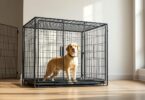Did you know that a 3-month-old puppy can hold its bladder for up to 3 hours? Understanding this and other key facts is crucial for successful house training. Establishing a routine early on sets the foundation for a harmonious home environment.
Consistency and clear boundaries are essential. Puppies thrive on routine, making schedules for feeding and potty breaks vital. Experts like Mary Burch emphasize that supervision and positive reinforcement are key during the early stages.
Crate training is a proven method to help with house training. It works because dogs naturally avoid soiling their sleeping areas. Regular potty breaks every 20-30 minutes during active play and after meals also significantly reduce accidents.
A well-trained puppy means fewer accidents and a happier home. By following these expert-backed methods, you can navigate the challenges of house training with confidence. This guide offers a step-by-step approach to help you and your puppy succeed.
Understanding Your Puppy’s House Training Needs
Recognizing your puppy’s signals is key to successful house training. Puppies often exhibit specific behaviors when they need to go, such as circling, sniffing, or even whining. These cues are crucial for pet owners to catch early.
Experts like Mary Burch note that puppies, especially in the first few months, have limited bladder control. A 3-month-old puppy can typically hold its bladder for about 3-4 hours, while a 6-month-old can manage up to 6 hours. This age-related ability is why consistent potty breaks are essential.
As your puppy grows, their signals may become more subtle. For instance, older puppies might simply wander towards the door, while younger ones might show more urgent behaviors like hunching. Tracking these patterns helps predict when your pet needs to go outside.
By paying attention to these signals and establishing a routine, you can reduce accidents and make house training more effective. Remember, every puppy is different, so tailoring your approach to their unique needs is important for long-term success.
Building a Consistent House Training Schedule
A well-structured daily schedule is the cornerstone of successful house training. Consistency helps puppies learn faster and reduces the chance of accidents. By creating a routine, you establish clear expectations for your puppy, making the learning process smoother for both of you.
Establishing Regular Potty Breaks
Expert recommendations suggest taking your puppy outside first thing in the morning, after meals, and before bedtime. These are critical times when puppies typically need to go. Additionally, hourly breaks during the day and after playtime are essential, especially in the early stages.
Adapting to Your Puppy’s Age and Needs
As your puppy grows, their bladder control improves. Younger puppies may need more frequent breaks, while older ones can wait longer. Observing your puppy’s behavior helps tailor the schedule to their unique needs, ensuring the process remains effective as they mature.
Stick to a routine to prevent accidents and build lasting habits. With time and consistency, your puppy will learn to go to the designated spot, making your life easier and your home cleaner.
Harnessing the Benefits of Crate Training
Crate training is a powerful tool for preventing indoor accidents and helping your puppy learn bladder control. By using a crate, you tap into your puppy’s natural instinct to keep their sleeping area clean. This method is especially effective at night, when puppies may not yet have the bladder capacity to hold their pee for extended periods.
Selecting the Right Crate for Your Puppy
Choosing the right-sized crate is essential for effectiveness and comfort. The crate should be large enough for your puppy to stand, turn, and lie down but not so spacious that they can pee in one corner. A crate that is too big may defeat the purpose, as your puppy may choose a corner to eliminate. Opt for a crate that allows your puppy to move comfortably without giving them excess space.
Creating a Safe and Comfortable Den
Make the crate a welcoming space by adding a soft bed or familiar toys. Introduce the crate gradually, starting with short periods and positive reinforcement. At night, place the crate in your bedroom to help your puppy feel secure and to make it easier to take them outside when needed. This approach helps your puppy associate the crate with safety and reduces the likelihood of accidents.
As your puppy grows, the crate will remain a valuable tool for reinforcing good habits and preventing bladder-related accidents. By using the crate consistently, you create a clear way to communicate when it’s time to go outside, especially at night. This method not only reduces accidents but also helps build a clean and orderly home environment.
Effective Tips for House Training Puppy
Positive reinforcement and consistent routines are key to successful potty training. By rewarding good behavior and handling accidents with patience, you can help your puppy learn faster and build a stronger bond.
Using Positive Reinforcement and Praise
Immediate praise and small treats are powerful tools. When your puppy goes to the designated place, celebrate with enthusiasm. This positive feedback helps them understand what you expect. Timing is crucial—reward your puppy within seconds of them going to the right spot to reinforce the behavior.
Use small, tasty treats and upbeat verbal praise to make the moment memorable. Over time, your puppy will associate going to the correct place with positive outcomes, making potty training easier and more effective.
Managing Accidents Constructively
Accidents are a natural part of the learning process. Instead of punishing your puppy, stay calm and clean up thoroughly. Use an enzymatic cleaner to remove odors, as your puppy’s sensitive nose can detect even faint smells that might draw them back to the same spot.
Never scold or punish your puppy for accidents. This can create fear and make the training process longer. Instead, focus on prevention by sticking to your schedule and supervising your puppy closely, especially in the early stages.
Addressing Common House Training Challenges
Every pet owner faces unique obstacles when teaching their puppy. Common issues include persistent accidents and adapting to special situations. These challenges can be overcome with the right approach.
Troubleshooting Persistent Accidents
First, identify why accidents happen. Check your schedule and supervision. Puppies thrive on routine, so ensure you’re taking them out every hour, especially after meals and play. If your puppy has a mistake, don’t scold them. Instead, clean the area thoroughly with an enzymatic cleaner to remove any lingering smells that might attract them back.
Implementing Solutions for Unique Situations
Some puppies need extra freedom or a different approach. If your puppy gets distracted easily, use a leash during potty breaks to keep them focused. For busy owners, adjust your schedule to fit your lifestyle, ensuring your puppy always has time to go outside. Every step you take to adapt your routine can make a big difference in their learning process.
Embracing a Lifetime of Successful House Training
Successful house training is more than just a short-term goal—it’s about building habits that last a lifetime. By establishing a consistent routine and using positive reinforcement, you set your puppy up for long-term success. Every time you take your puppy outside after meals or play, you reinforce good habits that will stick with them as they grow.
As your new puppy matures, the foundation you’ve laid will become second nature. Crate training, regular potty breaks, and plenty of praise are all tools that help create a well-behaved adult dog. Remember, every month-old puppy will eventually grow into a mature companion, and the habits you instill now will shape their behavior for years to come.
It’s important to periodically review and adapt your training practices as your puppy grows. Continuous reinforcement ensures that good habits remain strong. Over time, your puppy will learn to go to the litter area without prompting, making your life easier and your home cleaner. Embrace house training as an evolving process that adjusts to your pet’s needs, and you’ll enjoy a lifetime of responsible and predictable behavior from your furry friend.
FAQ
How often should I take my puppy outside?
Take your puppy outside every hour, especially after meals, naps, and playtime. As they grow, you can gradually extend the time between breaks.
What if my puppy has an accident in the house?
Stay calm and clean the area thoroughly with a neutral-smelling cleaner. Supervise your puppy more closely and maintain consistency in training.
Can I use potty pads and a crate?
Yes, potty pads are useful for small areas, and crates can help with bladder control. Introduce both gradually to avoid overwhelming your puppy.
How long does house training take?
Training duration varies, typically a few weeks to a month. Consistency and positive reinforcement can speed up the process.
Should I take my puppy out at night?
Yes, take your puppy out before bedtime. Limit water and activity in the evening to help them hold their bladder longer.
What are the best treats for training?
Use small, tasty treats your puppy loves, given immediately after good behavior to reinforce positive actions.










Leave a Comment